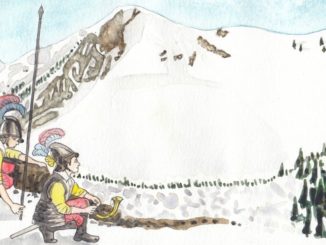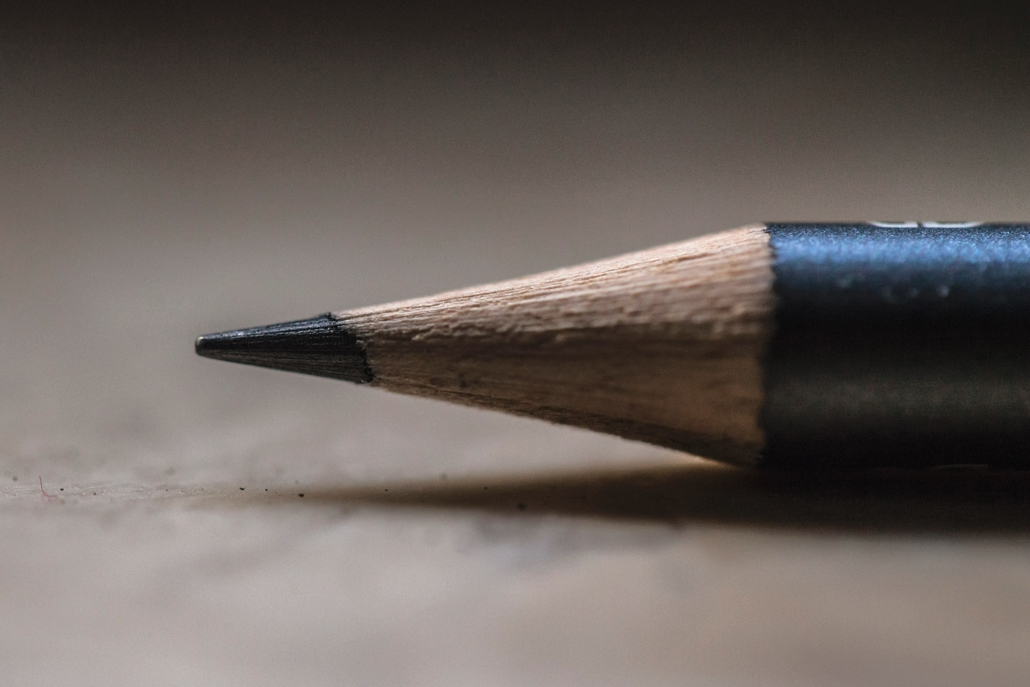
Before the pencil
Pens and ink have been in existence for a very long time, being used by the ancient Egyptians for writing and drawing on papyrus, a papery substance made by beating reeds flat. But these media are permanent, laborious to use, often messy, and expensive. There was always a need for something simpler and cheaper for writing rough notes or shopping lists, and preferably for something erasable so that it could be used again and again.
The ancient Greeks and Romans found this in the wax tablet: two small flat pieces of wood hinged together and folded double, with their inner surfaces coated with beeswax. You could scratch writing on the wax with a sharp metal stylus. When you had finished with your note it could be erased by melting the wax or smoothing it with the other end of the stylus, which was shaped like a small spoon.
This simple device was a bit bulky for the amount that could be written on it, but it was unrivalled while there was no paper available. Ancient Europeans had only parchment, a thin stiff form of leather, or vellum, a finer and better quality version made of calf skin. There were expensive and used only for books and official documents.
Paper, a Chinese invention made by boiling down vegetable fibres and compressing them into a sheet, arrived in Europe in the 13th century. At first it was very expensive but gradually the price came down. Scrap paper, the backs of documents written on one side, was and remains popular.
If you didn’t want to use ink on paper there was an option, though not a very good one. You could write with a dry stylus made of a soft metal which wore away, leaving traces of metal in the scratches on the paper. These traces would soon tarnish, leaving faintly visible writing – though it was hard to see what you were doing at the time. The usual metal was lead, whose exposed surface blackens in hours – the writing element in a modern pencil is still called the ‘lead’. For finer work such as drawings you could use a silver point on paper prepared with a slightly abrasive coating of powdered pumice stone. Leonardo did many silverpoint drawings.
Rough sketches, such as you might do in the early stages of a painting, could be done with sticks of charcoal, but the line was thick and vague and easily smudged.
There was still no way of erasing writing to reuse the paper. Parchment could be scraped clean of ink, especially ancient carbon ink made with soot, water and gum, which didn’t soak in and was quite easy to remove.
The discovery of graphite
Graphite is a form of pure carbon. Its atoms are arranged in flat sheets with very weak connections between the sheets, so that sheets can easily slide over each other or be rubbed off the surface. It’s black and shows up well on paper, and it’s reasonably resistant to smudging. Importantly, the lines can be erased.
It’s not a common mineral, but as it happened there was a large deposit in Borrowdale in Cumbria. It was discovered in the early16th century, according to legend when a tree was blown over in a storm exposing a deposit just under the soil. The locals called this soft, easily cut substance ‘wadd’ and used it for marking sheep. You would cut out a stick of wadd, wrap it with string or cloth to stop the soft greasy stuff from coming off on your fingers, and make marks with the exposed end. In fact it was a proto-pencil.
Graphite is also very resistant to heat. Larger blocks of it could be made into crucibles or cannonball moulds, and these came into use in the reign of Elizabeth I. The deposit was claimed by the crown and well guarded to stop unauthorised mining. Graphite would be mined periodically: when enough had been extracted for immediate use the mine was flooded to keep people out.
The first pencil
The crude wadd pencil was soon refined into a proper instrument that could be used for writing and drawing. The first known illustration of one is in the Swiss polymath Conrad Gessner’s book on minerals De omni rerum fossilium genere, gemmis, lapidibus, metallis, et huiusmodi, published in 1565. It shows a block of graphite and what we would call a ‘clutch’ pencil: a hollow wooden handle in which a thin rod of graphite gripped in a split wooden collar could be held by pushing the collar into the handle.
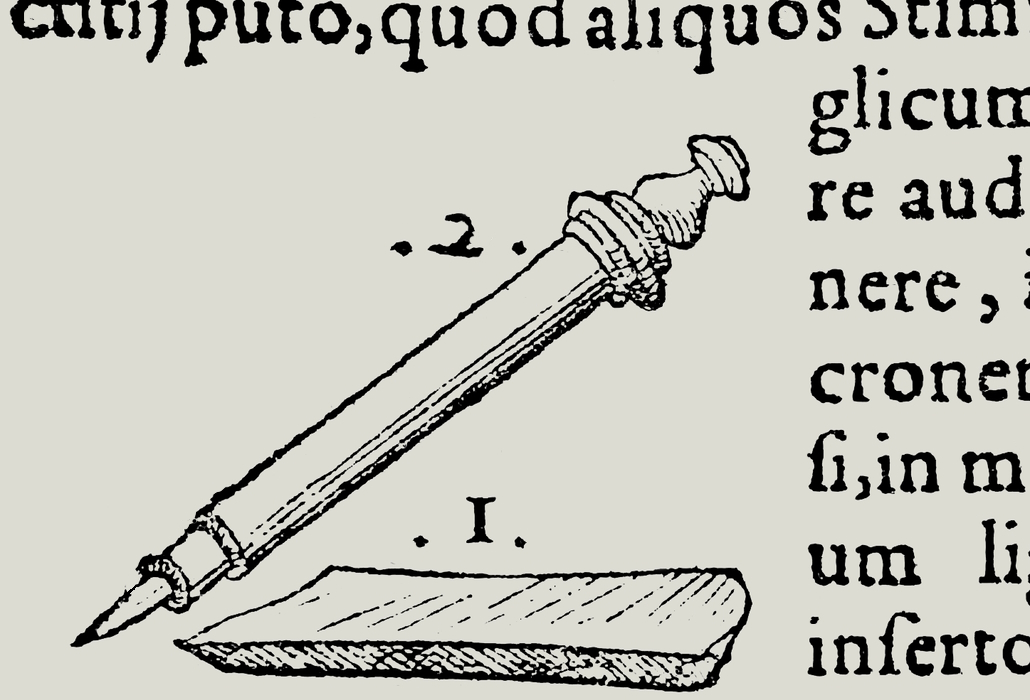
Public domain
In the text Gessner describes graphite as stimmi Anglicum, ‘English stibnite’. No one had any idea what this stuff was, maybe a form of lead or another metal, maybe not a metal at all. Stibnite – antimony sulphide, traditionally used for black eyeliner in Egypt and the Middle East – was as good a guess as any.
Gessner might have had to cut his own leads, a finicky process with a fine small-toothed saw, and also a wasteful one which produced a lot of black dust that got into everything around.
Rubbing out the marks
It was soon discovered that pencil marks could be erased by rubbing them with a little piece of fresh bread. It left the page covered with crumbs but these could be blown away. Try it: it works very well. This was the only way of erasing a pencil line for a surprisingly long time. The European invaders of Central and South America overlooked the native product of rubber, and it was not until 1736 that a sample was exhibited to the Académie Royale des Sciences in Paris. In 1770 Joseph Priestley reported ‘the very convenient method of wiping out writing made with a black-lead pencil, by means of gum elastic’, of which you could buy ‘a cubical piece, of about half an inch, for three shillings’ – a lot of money in those days. This, of course, is the origin of the name ‘rubber’. But we are getting ahead of the story.
The modern pencil emerges
Gesner’s pencil was a finely crafted object, not something for the mass market. If the pencil was to succeed it had to be cheap, simple and mass produced. The demand was met by the wood-cased pencil with a fixed lead, which could be sharpened by trimming off wood and lead with a penknife – a tool that every writer already had, as it was used for cutting quill pens to shape.
The oldest extant wood-cased pencil is in Japan, of all places, at the Kunozan Toshogu Museum in Shizuoka. It was given by a Dutch trader to the shogun Tokugawa Ieyasu (1543–1616) at the beginning of the 17th century, when he allowed the Dutch East India Company to set up a ‘factory’ – a trading post – in his country. It’s clearly recognisable as what we think of as a pencil, though the lead is much thicker than in a modern one.

Tachybaptus – Public domain
Curiously, modern analysis with an electron microscope has shown that the graphite came from a mine in Mexico, a sign of the Company’s wide trading interests. Graphite deposits are few and far between, and in Europe the rich Borrowdale mine would have a virtual monopoly until it was exhausted in the 19th century. Today much of the world’s graphite comes from a deposit in Sri Lanka.
The oldest pencil found in Europe was discovered when a 17th century house at Langenburg in Swabia was being renovated. It’s a carpenter’s pencil very like a modern one, with a wide case around a flat rectangular lead. The German pencil industry was quick to emerge: in 1662 a professional pencil maker in Germany, Friedrich Staedtler, was already making such things – using graphite from the Borrowdale mine, of course.

Tachybaptus – Public domain
How were these early pencils made? Unlike modern pencils, they were not formed of symmetrical halves. First, a wooden slat was cut, as thick as half a pencil plus the width of the lead – which, as seen in the Japan pencil, was fairly thick. The width of the slat was the length of a finished pencil, with the grain running crosswise. Slots were cut across the slat and along the grain to receive the lead.

Tachybaptus – Public domain
The lead itself was sawn out of a block of graphite, an exacting task. It was impossible to cut a ‘lead’ as long as a pencil, so early pencils had several strips of graphite along their length. When you ran out of one bit of lead you had to trim off quite a lot of wood to expose an adequate length of the next bit, a wasteful procedure. To save graphite, the top two inches of the pencil had no lead in it, since here it would have been unusable. You had to start sharpening your pencil at the right end.
The lengths of lead were glued into their slots with animal glue, which didn’t hold them securely – slippery graphite in its natural state can’t be stuck – but did keep them from rattling about in the slot.
Next, the surface of the slat was planed to grind off protruding graphite from the roughly cut leads. A thinner slat was glued to the first one to make up the full width of the pencil. Then the slat was sawn into individual pencils, which were smoothed down. The finished pencils might be square in section, or octagonal from shaving off the edges, or round.
Pencils were made in this way right up to the end of the 18th century, and in Europe they were made almost exclusively with the fine graphite from Borrowdale, which just happened to strike the right balance between hardness and blackness that made it most useful.
Dust
Sawing up blocks of graphite to make leads created a lot of graphite dust. This could be used for ‘blackleading’ grates and stoves – coating their fire-rusted surfaces with a heat-resistant shiny black coating to make them look tidier. A modern use is as a lubricant for locks that doesn’t make keys oily and pocket-staining. But Borrowdale graphite was becoming expensive, and people were looking for a way to recycle the dust and make it into pencils.
The first solution was to mix the dust with wax. This produced a lead like that of a modern colour pencil, which leaves a waxy line with particles of pigment in it. It’s all right for colouring drawings, but if you have ever tried to write with a colour pencil you will have found that the line is indefinite and patchy. There was also a serious problem: the only commonly available wax at the time was beeswax, which has a low melting point and softens on hot summer days, The point of the pencil would bend while you were writing. Sulphur, which can be easily melted, was also tried instead of wax, but the performance was little better.
Nevertheless, these second-rate pencils had a market because they were cheaper. They were made on a large scale in Germany by firms such as that of Staedtler, which is still in business making writing implements of various kinds.
Conté’s invention
During the Napoleonic Wars the Royal Navy’s blockade of France made it impossible for the French to import graphite from Britain, and there was an urgent need to make serviceable pencils from surplus graphite dust. The solution was found in 1795 by Nicolas-Jacques Conté, a one-eyed army officer whose interests included ballooning and painting.
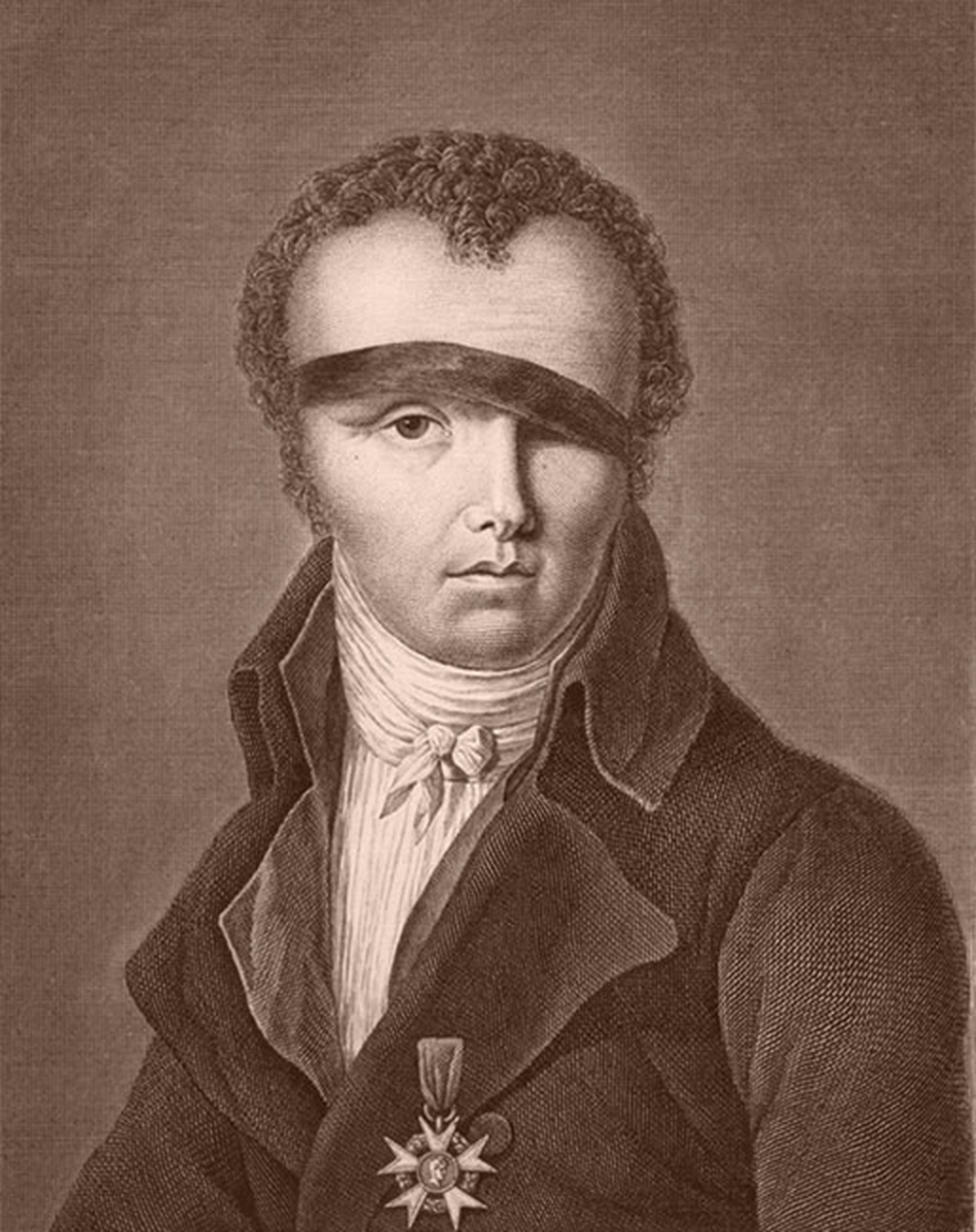
Public domain
His idea was to mix graphite dust with clay and fire the mixture as a ceramic material. It worked brilliantly. The pencil leads he made were cylindrical in cross section, replacing the old square leads of natural graphite. They could be made in any length and diameter. Most importantly, varying the proportions of graphite to clay allowed leads of different hardness to be made: the more clay, the harder the lead and the better it could be sharpened to give a narrow clean line. The old natural graphite pencils had given a very black but rather broad and vague line, like writing with a modern 6B or 7B artist’s pencil. Now the pencil was a precision instrument suitable for technical drawing.
Conté also invented the coloured crayons that still bear his name, thicker but made by a similar process with solid pigments instead of graphite.
The Conté pencil was made in a different way from the traditional one. The wooden slats were now the thickness of a finished pencil, with a deep groove into which the pre-formed lead could be dropped. Narrow strips of wood were then glued into the grooves above the leads to hold them in, after which the top of the slat was planed flat and the individual pencils sawn out and finished.
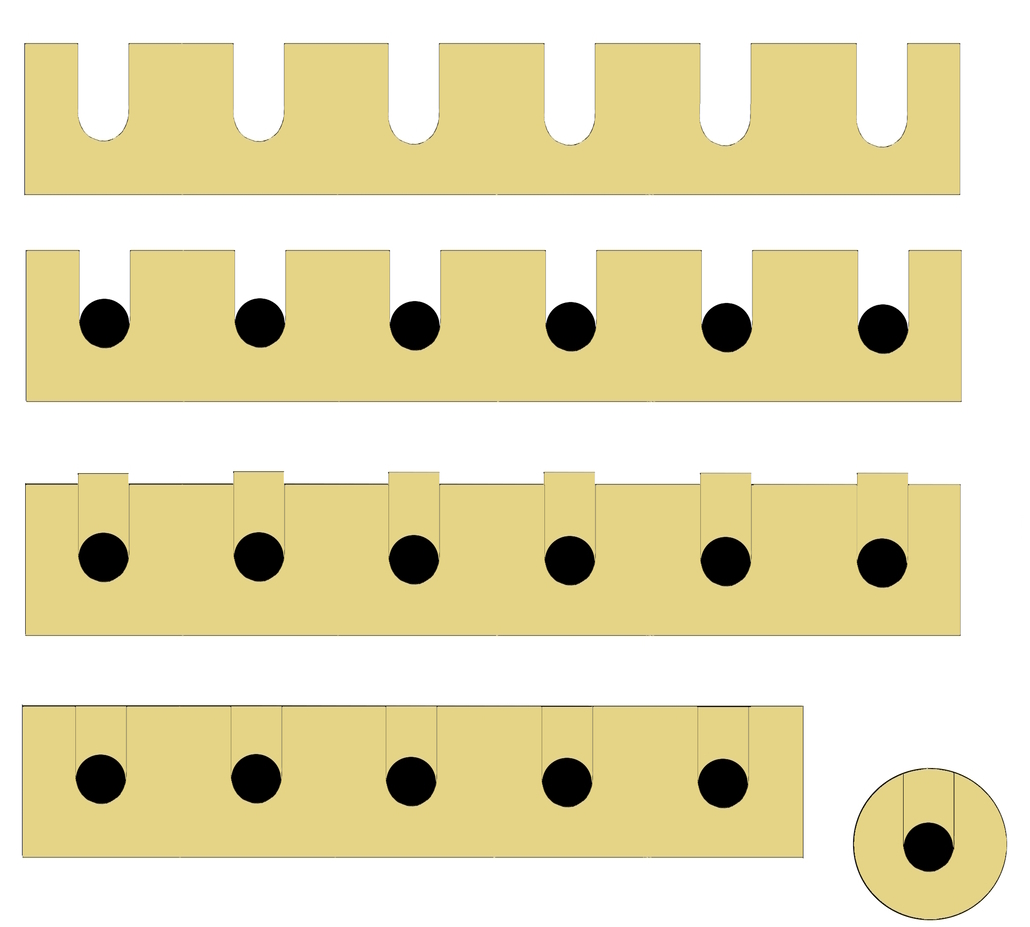
Tachybaptus – Public domain
The 19th century
During the following decades, as the population grew rapidly, people moved into cities, and basic education became almost universal, the demand for pencils greatly increased, and their production was mechanised. In Europe, German pencils – now, of course, with modern fired leads – dominated the European markets, and as the United States grew so did its pencil industry.
The most famous pencil manufacturer of all time was Henry David Thoreau (1817–1862), though not because he ran his family’s pencil factory in Concord, Massachusetts well enough but because in 1845 he tired of worldly affairs and decided to live alone for five years in a small cabin on Walden Pond. Showing a certain talent for self-publicity, he emerged from his self-imposed exile to write a book, Walden, published in 1854, which is considered a classic of American literature. In it, he declared rather cloudily, ‘I went to the woods because I wished to live deliberately, to front only the essential facts of life, and see if I could not learn what it had to teach and not, when I came to die, discover that I had not lived.’ The book includes a list of the essentials he took with him to his cabin – but it omits pencils, without which he could not have taken his notes. As a manufacturer of these essential things he no more noticed pencils than a fish notices the water.
In March 2023 a perfectly ordinary pencil from the Thoreau factory sold at auction for $2200.
Mass production changed the form of the pencil to the one we know today. With modern machine tools pencil slats can be made in symmetrical halves so that only one type of wooden component needs to be machined. The pencils are roughly rounded before they are sawn apart, smoothed, and painted or varnished. The big manufacturers chose distinctive colour schemes.
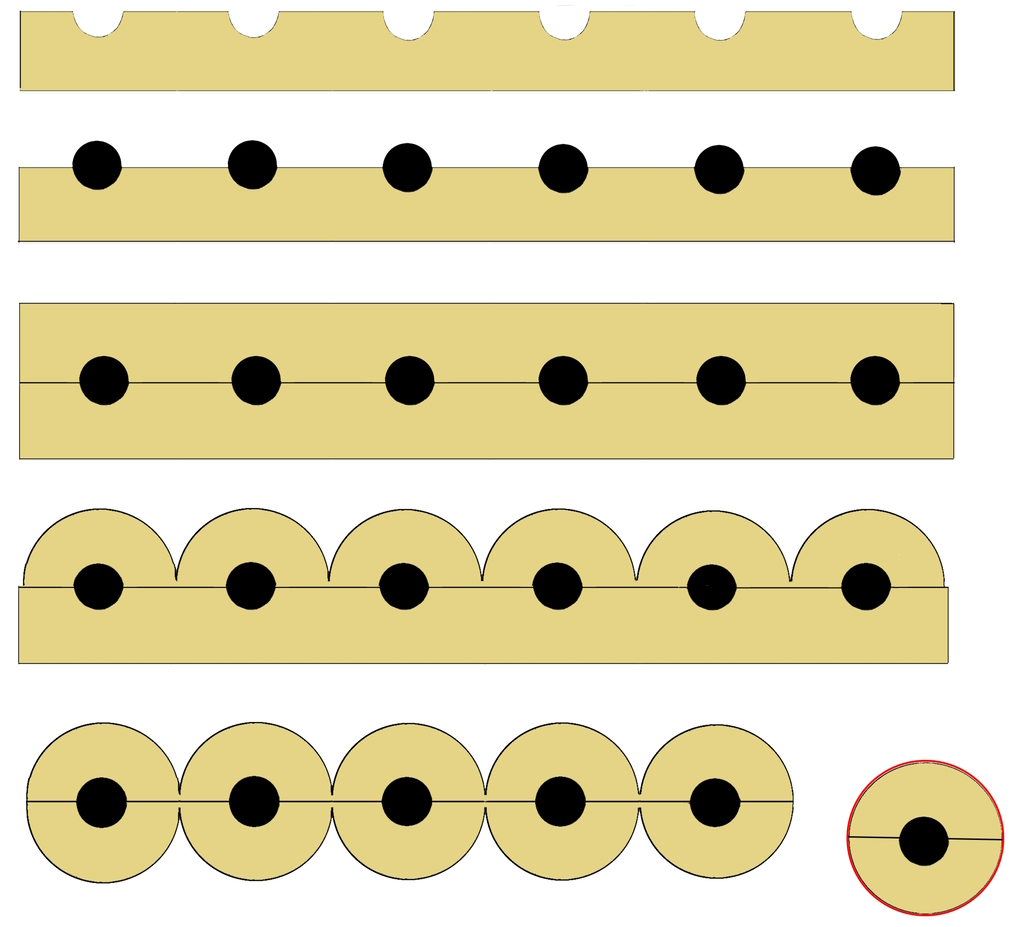
Tachybaptus – Public domain
The best pencils were made of red cedar wood, soft enough to be sharpened easily with a knife, attractively coloured and fragrant. Demand increased to a point where by 1900 the tree was almost extinct and all kinds of things made of red cedar were being sawn up and recycled. A substitute was found in incense cedar which, in spite of its name, has little fragrance. The wood is also quite pale. If you buy a high quality pencil now it will be dyed and scented to imitate the original wood. Cheap pencils, of course, are made of any old timber and may be hard to sharpen cleanly.
In the 1850s the large German firm of Faber-Castell introduced the pencil with an eraser attached to the top with a metal sleeve. When a certain Hymen Lipman tried to patent the idea in the USA, Faber-Castell challenged him and won.
The mechanical pencil
The wooden pencil was rivalled, but never very seriously, by the metal ‘mechanical’ or ‘propelling’ pencils with a slim lead that could be screwed out a bit at a time to save the task of sharpening. They first appeared at the end of the 18th century but never really got much of the market, being complex and expensive, and the thin lead snapped easily and never gave more than a faint line. They were often presented as gifts, teamed with a fountain pen as part of a ‘pen and pencil set’, but not much used. However the clutch pencil, with a fairly thick lead gripped in metal jaws released by a button on the top of the pencil – very similar to Gesner’s pencil from three centuries earlier – remains in use in drawing offices as a rough sketching tool.

Public domain
The pencil sharpener
In the age of the quill pen everyone who wrote had a penknife, a small sharp blade in a long wooden handle, for shaping quills. But as metal nibs became usual there was less use for these knives and they began to disappear. (In fact they survived for a remarkably long time after they became useless, and when my father was working at the Foreign Office in the 1950s the official Stationery Office still provided one for every desk. I have two.)
So there was a growing demand for a means of sharpening a pencil without the chore of careful whittling while taking care not to break the lead. The first mechanical sharpener, a box containing small files into which a pencil could be inserted and rotated to grind the tip to shape, was described by a Monsieur C.A. Boucher in 1822. It was a complex thing and never made it to the market. But soon other devices were being sold for use in offices, mostly with rotating grinders so that a pencil could be sharpened by sticking it in a hole and cranking a handle. Such machines persist to this day, now with electric motors.
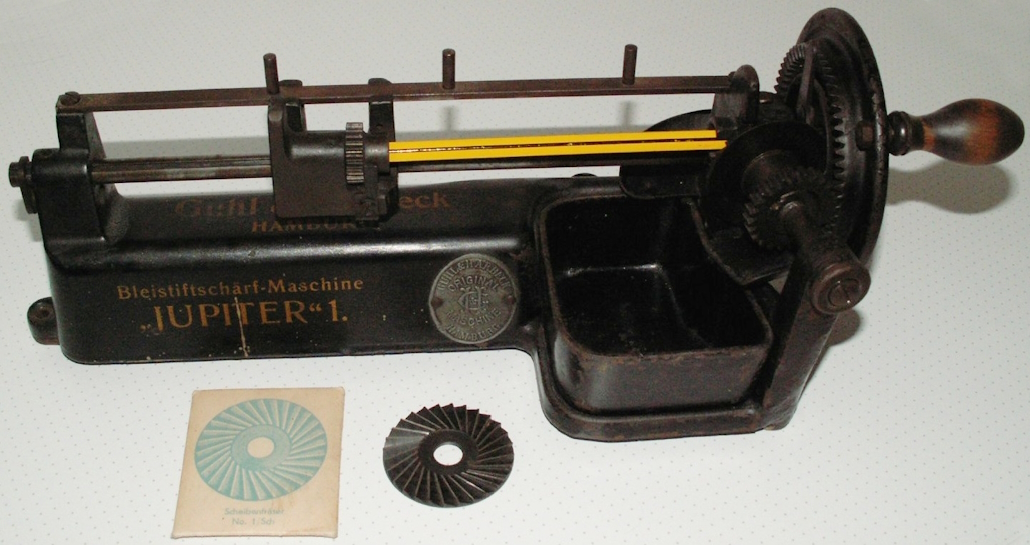
Photo by ChiemseeMan – Public domain
The small simple ‘prism’ sharpener, a block with a conical hole in which a pencil can be turned against a blade, appeared later. It’s now the most used kind of sharpener, small, convenient and cheap, and does a good job while the blade is sharp and it’s used with care. It produces shavings and graphite dust which can make a mess, and some models have the works enclosed in a container to catch the shavings.
The 20th century and later
Cheap pencils sold today are in no way superior to those of the later 19th century. It’s a ‘mature technology’ with little reason to change it, like the basic form of the racing bicycle or the cricket bat.
But there have been advances at the expensive end of the market. One of the most serious problems of the basic pencil is that the lead is not firmly held in the wood: slippery graphite resists being glued in place. If you snap a brittle lead by pressing too hard, often the break is some way up in the wood. There is a short piece of lead that flops around, splitting the wood, and can’t be used. You have to sharpen the pencil back to above the break, wasting a lot of its length.
Various attempts were made to bond the graphite to the wood, but the most effective one was developed in the USA in 1933 by the Eagle pencil company: the ‘Chemi-Sealed’ method. The graphite leads were first dipped in sulphuric acid and then bathed in a solution of calcium chloride, causing a reaction that deposited a firmly bonded layer of gypsum, calcium sulphate, on the surface. This layer was not slippery and could be firmly glued. Also the wood was impregnated with a resinous binder to keep it from splitting.
Other leading companies soon developed their own processes, similar but not so close as to infringe Eagle’s patent.
The lead itself also received attention. Conté’s fired ceramic leads were brittle, a weak point in the design. High quality leads are now blended with a polymer material – a hardish plastic – that gives them a slight flexibility and resistance to snapping.
A few manufacturers have abandoned wood entirely and are using a plastic casings, giving a pencil that, while stiff enough to write with, can be bent considerably without breaking its polymer lead. But they are more difficult to sharpen and, to a habitual pencil user, don’t feel right.
So here we have it, a fully evolved writing implement where any changes are minor and not necessarily in the right direction.
The advent of plastics that could be made with any desired characteristics also brought the plastic eraser, far superior to natural rubber ones.
During the US space program of the 1960s, astronauts found that the ballpoint pens they were given for taking notes didn’t work in zero gravity, as they needed gravitational pull to make the ink flow down to the ball. To solve the problem NASA spent a million dollars developing the ‘Space Pen’ with a gas-pressurised ink reservoir to force the ink to the writing point. I have one of these, given to me as an expensive present, and yes, it does write at any angle.
But when the joint US–Russian space project was set up in 1975, and the Apollo astronauts came into the Soyuz capsule through the airlock, they found the Russian cosmonauts happily taking notes with a pencil, unaware that there had ever been a problem.
© Tachybaptus 2023


